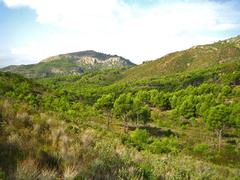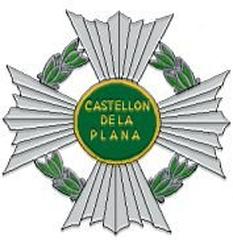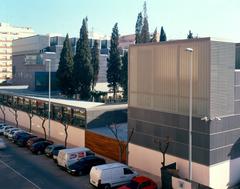
Comprehensive Guide to Visiting Castelló de la Plana, Plana Alta, Spain
Date: 13/08/2024
Captivating Introduction
Welcome to Castelló de la Plana, a city where history whispers through the cobbled streets and the Mediterranean sun bathes everything in a golden glow. Did you know that Castelló de la Plana was strategically relocated in 1251 by Jaime I El Conquistador? Imagine the streets filled with locals on a vibrant pilgrimage to the Hermitage of the Magdalena, celebrating this historic move every year (Castellón Turismo). Nestled in the fertile lands of the Plana region, this city is a treasure trove of history, culture, and natural beauty.
As you wander through Castelló de la Plana, you’ll encounter the majestic El Fadrí bell tower, a 15th-century marvel offering panoramic views after a 200-step climb. Picture the bustling markets of the Middle Ages, the aroma of fresh produce, and the chatter of merchants. Fast forward to the golden era of the 17th and 18th centuries, with architectural wonders like the Church of Santa María and the Lonja del Cáñamo (Castellón Turismo).
This guide will take you through the rich tapestry of Castelló de la Plana, from its historical landmarks to hidden gems, offering insider tips and quirky local customs. Whether you’re here for the vibrant La Magdalena festival or to savor ‘arroz a banda’ by the Mediterranean Sea, Castelló de la Plana promises an unforgettable experience. So, lace up your walking shoes, grab your camera, and let’s dive into the wonders of this enchanting city.
Table of Contents
- Historical Overview of Castelló de la Plana
- Medieval Beginnings and Relocation
- Urban Development in the Middle Ages
- Architectural and Economic Growth in the 17th and 18th Centuries
- Castelló de la Plana in the 19th Century
- Modern Developments and Cultural Significance
- Key Historical Landmarks
- Annual Festivities
- Visitor Tips
- Local Secrets and Hidden Gems
- Cultural Context and Etiquette
- Sensory Descriptions
- Interactive Elements
- Seasonal Highlights
- Time-Based Itineraries
- Local Lingo Lessons
- Myth Busting and Surprises
- Storytelling Elements
- FAQ
- Call to Action
A Journey Through Time in Castelló de la Plana
Medieval Beginnings and Relocation
Imagine a bustling medieval town, nestled in a different location, before the wise Jaime I El Conquistador decided to move it to the more fertile lands of the Plana region. On September 8, 1251, he gave his lieutenant, Ximén Pérez de Arenós, the green light to relocate the town. This historic move is celebrated every year with a lively pilgrimage to the Hermitage of the Magdalena on the third Sunday of Lent. Picture the streets filled with locals, marching with joy, retracing the steps of their ancestors (Castellón Turismo).
Urban Development in the Middle Ages
Fast forward to the medieval centuries, and you’ll find a city buzzing with craft and commercial activities. The ingenious use of water from the Mijares River transformed the land, making agriculture bloom. Close your eyes and envision the lively markets, the chatter of merchants, and the aroma of fresh produce wafting through the air (Castellón Turismo).
Architectural and Economic Growth in the 17th and 18th Centuries
The 17th and 18th centuries were a golden era for Castelló de la Plana. The city shed its medieval cloak and embraced growth. Think of the bell tower ‘El Fadrí’ standing tall since 1604, the majestic Church of Santa María expanding, and the bustling Lonja del Cáñamo teeming with traders. The new Town Hall? Picture a symbol of civic pride, gleaming under the sun (Castellón Turismo).
Castelló de la Plana in the 19th Century
The 19th century was a rollercoaster for Castelló de la Plana. Imagine the city walls crumbling, making way for new growth, only to be halted by the War of Independence against Napoleon and the Carlist Wars. Despite these upheavals, Castelló de la Plana rose as the capital of a new province in 1833. The railway’s arrival, port expansion, and construction of significant buildings like the Provincial Hospital, Casino, and Theater marked a period of renaissance (Wikipedia).
Modern Developments and Cultural Significance
Fast forward to 1991, and Castelló de la Plana welcomed Jaume I University, adding a modern educational facet to its historical charm. Picture a city where industry, tourism, and craft-work coexist harmoniously, under a sky that boasts an average of 2,800 sunshine hours a year, inviting tourists to bask in its warmth (Wikipedia).
Key Historical Landmarks
Santa María la Mayor Co-Cathedral
Step inside the Santa María la Mayor Co-Cathedral, and let the Gothic architecture and stunning stained-glass windows take your breath away. Imagine Baroque images and paintings whispering stories of the past, with an 18th-century image of La Inmaculada standing as a silent testament to the city’s rich heritage (Comunitat Valenciana).
El Fadrí Bell Tower
Adjacent to the co-cathedral stands El Fadrí, a 15th-century bell tower with a spiral staircase of over 200 steps. Climb it, and be rewarded with extraordinary views that make the effort worthwhile. El Fadrí isn’t just a monument; it’s a beloved symbol of Castelló de la Plana (Comunitat Valenciana).
Lonja del Cáñamo
The Lonja del Cáñamo, dating between 1606 and 1617, is a late Renaissance gem declared a Historic and Artistic Monument in 1984. Picture its ground floor buzzing with exhibitions and events, while the upper floor remains a private haven (Comunitat Valenciana).
Muralla Liberal
The Muralla Liberal, remnants of the Carlist city walls, whisper tales of the city’s strategic importance during the 19th-century Carlist Wars. Walk among these ruins, and let your imagination paint a picture of the past (Comunitat Valenciana).
Annual Festivities
Come three weeks before Easter, and the city bursts into celebration with the La Magdalena festival. Picture a week-long fiesta with international bands and groups, as locals and visitors commemorate the city’s founding with a vibrant pilgrimage to the Hermitage of the Magdalena (Wikipedia).
Visitor Tips
For those planning to visit Castelló de la Plana, here are some practical tips:
- Getting There: Direct flights to Castellón Airport are available from several European cities. Alternatively, visitors can fly into Valencia, Alicante, or Barcelona and take a train or bus to Castelló de la Plana (Heather on Her Travels).
- Accommodation: From beachfront hotels in the Grao district to historic inns in the old town, the city offers a range of accommodation options.
- Local Cuisine: Don’t miss ‘arroz a banda,’ a savory rice dish cooked in fish stock, served separately from the fish and seafood broth. Imagine the flavors dancing on your palate (Fascinating Spain).
- Exploring the City: Stroll through the historic center, visit the Central Market, and unwind in Ribalta Park. The city’s beaches, such as El Pinar and Gurugú, offer a perfect spot to bask by the Mediterranean Sea (Comunitat Valenciana).
Local Secrets and Hidden Gems
While the well-known landmarks are a must-see, don’t miss the lesser-known spots. How about a visit to the quirky Museu de Belles Arts, or exploring the hidden alleys of the old town where local artisans craft their masterpieces? Feel the heartbeat of the city in these hidden nooks.
Cultural Context and Etiquette
Embrace the local customs with a smile. Greeting locals with a friendly ‘Hola!’ can open doors, and remember, siesta time is sacred—expect shops to close in the afternoon. Dive into the local rhythm and enjoy the laid-back lifestyle.
Sensory Descriptions
Castelló de la Plana is a feast for the senses. Smell the salty sea breeze, hear the echoes of history in the cobbled streets, taste the rich flavors of the local cuisine, feel the warm sun on your skin, and see the vibrant colors of the festivals.
Interactive Elements
Why not turn your visit into a treasure hunt? Find the hidden murals scattered across the city, or collect stamps from local landmarks to create a unique souvenir of your journey. Engage with Castelló de la Plana in a new, playful way.
Seasonal Highlights
Each season brings a new charm to Castelló de la Plana. Spring blooms with festivals, summer invites you to its sun-kissed beaches, autumn offers a harvest of local delicacies, and winter wraps the city in a cozy, festive atmosphere. There’s always a reason to visit!
Time-Based Itineraries
Whether you have a day, a weekend, or a week, Castelló de la Plana has something for you. Imagine a choose-your-own-adventure story: start with a morning market visit, an afternoon at the beach, and an evening of tapas. Customize your journey to fit your time and interests.
Local Lingo Lessons
Brush up on your Valencian with a few key phrases. Try ‘Bon dia!’ for good morning, or ‘Gràcies’ for thank you. Sprinkle these into your conversations and watch the locals’ faces light up with appreciation.
Myth Busting and Surprises
Did you know Castelló de la Plana isn’t just about history? It’s a hub for modern art and innovation too. Challenge the misconception that it’s just a sleepy historical town—discover its vibrant, contemporary side.
Storytelling Elements
Every corner of Castelló de la Plana has a story. From the legend of Jaime I’s relocation to the whispered tales of El Fadrí’s construction, these narratives bring the city’s history to life. Let yourself be transported back in time with each story you uncover.
FAQ
- What’s the best time to visit? Anytime! Each season offers a unique experience.
- How do I get around? Walking and cycling are great options, but local buses and taxis are available too.
- What should I pack? Comfortable shoes, sunscreen, and a curious spirit!
Call to Action
Ready to explore Castelló de la Plana like a local? Download Audiala, your ultimate guide to the city. Discover hidden gems, enjoy interactive tours, and immerse yourself in the rich history and vibrant culture of Castelló de la Plana. Your adventure awaits!
Conclusion
As your journey through Castelló de la Plana comes to an end, it’s clear that this city is much more than a historical destination. From the bustling Mercado Central to the serene Parque Natural del Desierto de las Palmas, Castelló de la Plana offers a delightful blend of past and present (Castellón Turismo). The city’s evolution from a medieval town to a modern hub of industry, tourism, and education is a testament to its resilience and charm.
Whether you’ve marveled at the Gothic architecture of Santa María la Mayor Co-Cathedral or climbed the spiral staircase of El Fadrí for breathtaking views, Castelló de la Plana has something for everyone. The local festivals, like the week-long La Magdalena, bring the city’s vibrant culture to life, while the hidden alleys and quirky museums offer a glimpse into its soul (Wikipedia).
Ready to uncover more? Download Audiala, your ultimate guide to Castelló de la Plana, and immerse yourself in the city’s rich history and vibrant culture. With expert insights and hidden gems, Audiala ensures that every step of your journey is enriched with stories and secrets waiting to be discovered. Your adventure in Castelló de la Plana awaits.
References
- Castellón Turismo. (n.d.). The City: History & Origins. Retrieved from Castellón Turismo
- Wikipedia. (n.d.). Castellón de la Plana. Retrieved from Wikipedia
- Comunitat Valenciana. (n.d.). Mediterranean in Action: Castelló de la Plana. Retrieved from Comunitat Valenciana
- Heather on Her Travels. (n.d.). 10 Things to Do in Castellón, Spain. Retrieved from Heather on Her Travels
- Fascinating Spain. (n.d.). Wonders of Castellón to See Once. Retrieved from Fascinating Spain




